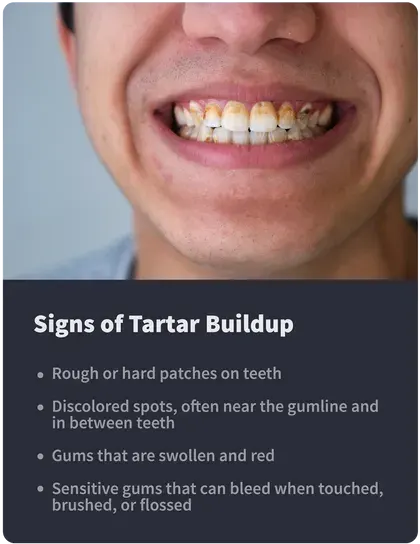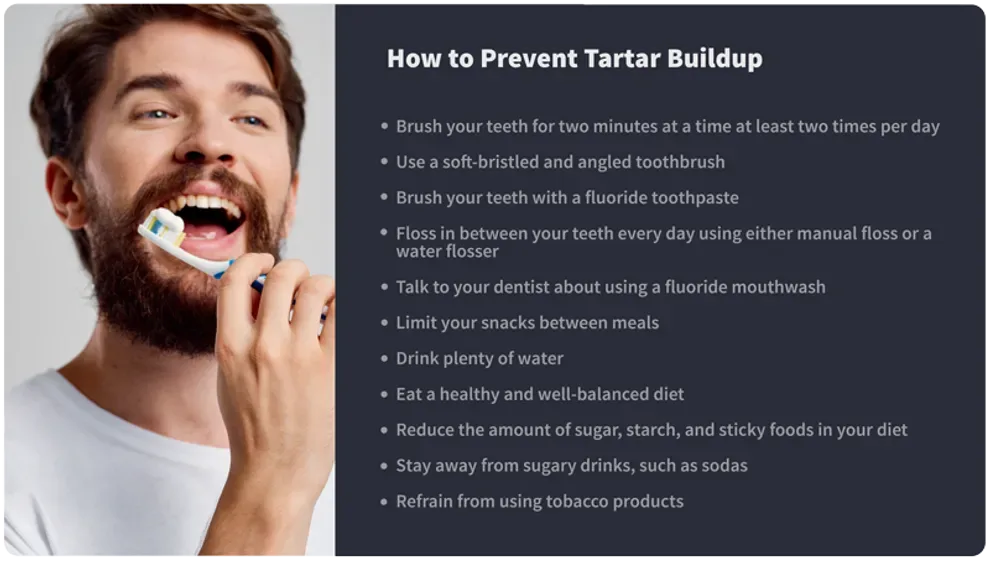Spotting & Treating Tartar Buildup: What Does It Look Like?

Table of Contents
- What Is Tartar?
- Recognizing Tartar Buildup
- Treatment Options
- Additional Issues
- Prevention
- References
Tartar is typically darker in color than plaque, it is often yellowish looking and feels rough to the touch. Once tartar has formed on your teeth, it will need to be removed by a dental professional. Untreated tartar buildup can lead to tooth decay and gum disease.
Tartar, also called dental calculus, forms on your teeth when plaque is not removed. Plaque is a sticky film that is caused by the interaction of the bacteria in your mouth and acids from foods, especially sugary or starchy ones. When plaque is allowed to stay on your teeth, it hardens into tartar.
To keep tartar from building up, it is essential to brush and floss your teeth regularly as well as keep up with routine dental appointments.
What Is Tartar?
Plaque is a sticky film that forms on our teeth, regularly coating them. It is colorless and often unnoticeable.
When we eat certain foods, especially those that are sticky, full of sugar, or overly starchy, the acids in these foods interact with the bacteria in the plaque. This can lead to the breakdown of minerals in the hard outer protective layer of our teeth, the enamel. Plaque is sticky and keeps the acids in contact with the teeth.
If the plaque is not regularly removed and is allowed to stay on the teeth, it can collect and form into tartar. Tartar is a hard, rough calculus that cannot be removed without professional dental help.
Tartar buildup can cause irritation and inflammation in the mouth, leading to gingivitis (gum disease) as well as tooth decay and cavities.
Recognizing Tartar Buildup

Since you cannot see plaque, it can be difficult to know when it is on your teeth and that it is forming into tartar. Tartar is often darker in color than plaque. It is often yellowish, but it can also be colorless and hard to spot.
One of the ways to recognize tartar is by its rough texture. It can often feel scratchy to the tough, as it is hard and not going to be as smooth as your tooth normally is.
Some of the signs of tartar buildup can include:
Rough or hard patches on the tooth.
Discolored spots, often near the gumline and in between teeth.
Gums that are swollen and red.
Sensitive gums that can bleed when touched, brushed, or flossed.
If you notice any of these signs of tartar buildup, contact your dentist right away for a checkup and professional cleaning.
Tartar is comprised mainly from mineralized dead bacteria, in addition to a small amount of mineralized proteins from saliva.
Treatment Options for Tartar Buildup
The only way to remove tartar after it has formed on your teeth is via an oral cleaning done by a dental professional. You can remove plaque by practicing proper oral hygiene, but once that plaque has hardened into tartar, your toothbrush is not strong enough to remove it.
Your dentist will examine your teeth to assess the level of tartar buildup to determine how to remove it. Typically, a dental cleaning will involve using a scaler to remove and scrape off the tartar. This tool can be either manual or ultrasonic, and it works to remove tartar buildup from your teeth.
The dental hygienist will often use both forms of scalers to clean your teeth. The manual scaler has a pointed end to get to the tartar above the gumline, and a blunt and curved hook like end to remove tartar that has built up under the gumline. Ultrasonic scalers use high frequencies and vibrations to break down and remove tartar.
Scaling and root planing is a deeper cleaning treatment option that is needed when tartar forms underneath the gumline. During this procedure, the dentist or dental hygienist will scale your teeth both above and below the gumline to remove the tartar buildup and then smooth out the roots of your teeth with root planing.
When Tartar Buildup Causes Additional Issues
It can be tricky to spot tartar buildup in time to prevent gingivitis, the early stage of gum disease, or tooth decay. Both early stages of gum disease and tooth decay can be reversed with the help of a dental professional. A professional cleaning is often enough when followed with proper oral hygiene practices.
The enamel on your teeth can repair itself during the early stages of decay, but once the enamel is gone, it is gone for good. This is when cavities form, which are holes in your teeth caused by tooth decay.
When tartar buildup has caused tooth decay, cavities, or gum disease, additional treatments may be needed, including:
This involves filling the hole left by a cavity with a composite, metal, or amalgam material.
These clean out tooth decay and bacteria down under the tooth and in the root.
These are used when a regular filling is too small, or they may be put on top as a type of tooth “cap” after a root canal or to help reshape and strengthen a tooth.
This is only used in extreme cases of significant decay. Often, the tooth will then need to be replaced with a dental implant or bridge.
Prevention of Buildup & Tartar Control

The best treatment for tartar buildup is to prevent it from forming in the first place. You can do this be practicing good oral hygiene and removing the plaque so it does not have the opportunity to harden into tartar.
If you get tartar buildup and need to have it removed by a dental professional, you can keep it from coming back again by doing the following:
Brush your teeth for two minutes at a time at least two times per day.
Use a soft-bristled and angled toothbrush.
Brush your teeth with a fluoride toothpaste.
Floss in between your teeth every day using either manual floss or a water flosser.
Talk to your dentist about using a fluoride mouthwash.
Limit your snacks between meals.
Drink plenty of water.
Eat a healthy and well-balanced diet.
Reduce the amount of sugar, starch, and sticky foods in your diet.
Stay away from sugary drinks, such as sodas.
Refrain from using tobacco products.
You will also need to schedule regular dental checkups and have your teeth professionally cleaned routinely. The American Dental Association (ADA) recommends seeing your dentist as often as necessary for regular cleanings.
Each person has different levels of oral health and therefore different dental needs. On average, most people will likely need to see their dentist twice a year, or once every six months. If you are prone to tooth decay or gum disease, you may need to visit your dentist more often.
